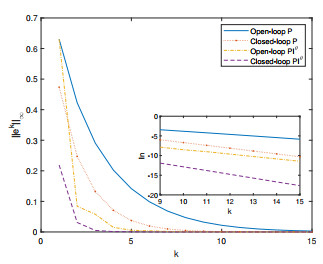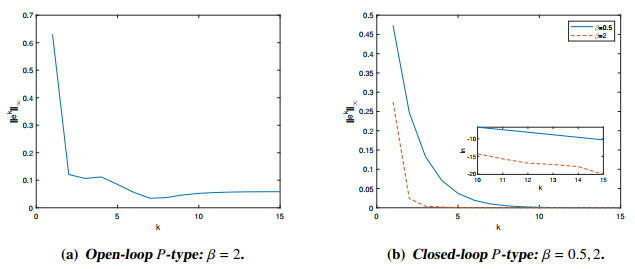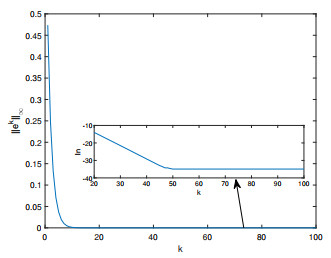1.
Introduction
In this paper, we study a conformal Hessian quotient inequality:
where SkSl(Agu):=SkSl(λ(Agu)), 0≤l<k≤n, k∈N+, l∈N, u is the unknown function, α is a non-negative constant. Note that in Euclidean space Rn, the conformal Hessian matrix Agu in (1) has the form
where a(x) and b(x) denote the functions of x, Du and D2u denote the gradient vector and Hessian matrix of u respectively, I is the n×n identity matrix. In (1), the operator Sk denotes the Hessian operator or the k-th order elementary symmetric polynomial given by
where k=1,…,n, i1,…,is∈{1,…,n} and λ=(λ1,…,λn) denotes the eigenvalues of the matrix Agu. Sk(Agu):=Sk(λ(Agu)) denotes the sum of the k×k principle minors of the matrix Agu. As usual, we define S0(λ)≡1, see [17]. Then, naturally we can define the quotient operator in (1) to be
When l=0, the leading term Sk(Agu) in the inequality (1) is related to the k-Yamabe problem, see [15,18]. Specially, when k=1, it is related to the well-known Yamabe problem, see [1,2,14,16,19]. According to Caffarelli-Nirenberg-Spruck (see [4]), we say that u is a k-admissible function of (2) if
We give the following nonexistence result of positive k-admissible solution of the inequality (1).
Theorem 1.1. The inequality (1) with Agu in the form (2) has no entire positive k-admissible solution in Rn for either infx∈Rn(na(x)−b(x))≥0, α>0 or infx∈Rn(na(x)−b(x))>0, α≥0.
Remark 1. Note that the functions a(x) and b(x) should satisfy the conditions in Theorem 1.1. When a(x) is positive, b(x) can be positive or negative. When a(x) is negative, b(x) can only be negative.
The above theorem is a nonexistence result of positive solutions to a single Hessian quotient inequality. Naturally, we can consider the system of Hessian quotient inequalities. We then study the following system of Hessian quotient inequalities:
where α≥0, β≥0, 0≤l<k≤n, 0≤l′<k′≤n, k′∈N+, l′∈N, Agu is defined in (2), and
If a k-admissible u and a k′-admissible v satisfy (6), we call (u,v) the (k,k′)-admissible solution pair. In some situation, we need to assume that
holds for some constant p≥1.
We formulate the nonexistence result of positive admissible solution of the coupled inequalities (6).
Theorem 1.2. Assume that the system (6) of Hessian quotient inequalities satisfies (2) and (7). Assume also that either infx∈Rn(na(x)−b(x))≥0, α>0, β>0, (8), or infx∈Rn(na(x)−b(x))>0, α≥0, β≥0 hold. Then the system (6) has no entire positive (k,k′)-admissible solution pair (u,v) in Rn.
We recall some related studies on the entire solutions of Hessian equations and Hessian inequalities. The classification of the nonnegative entire solutions of the equation
had been deduced for 1≤α<n+2n−2 in [5] and α=n+2n−2 in [3], respectively. The similar classification results are extended in [8] to admissible positive solutions of the conformal k-Hessian equations
where g=u−2dx2 is a locally conformally flat matrix in M, Agu is given by Agu=g−1Ag0u, g0 is a given metric on M. In [11], the same classification result for special case of Rn (n=2k+1) is also obtained by suitable choices of the text functions and the argument of integration. Using the method as in [5] and [11], a nonexistence result of the Hessian inequality
is proved in [12] for 2k<n and α∈(−∞,nk/(n−2k)]. The conformal k-Hessian inequality
with Agu=u(D2u)−12|Du|2I is considered in [13], where the nonexistence results for 2k<n and α∈[k,∞) is formulated. The conformal k-Hessian inequality Sk(Agu)≥uα with Agu=D2u−(12|Du|2I−Du⊗Du) is considered in [6]. Note that Agu in (2) has a similar structure to that in [6], but our Agu here is more general because of the existence of a(x) and b(x).
The organization of this paper is as follows. In Section 2, we first formulate a nonexistence result, Lemma 2.1, for an inequality involving the Laplace operator. Then we give its proof by appropriate choice of text functions and the method of integration by parts. The proof is divided into two cases according to α and the coefficient of the |Du|2, where Schwarz's inequality and Young's inequality are properly used. In section 3, we establish the relations between Hessian quotient operator and the Laplace operator by using Maclaurin's inequality. Based on this relationship and Lemma 2.1, we prove the nonexistence result in Theorem 3.2. The proof of Theorem 1.1 is completed by using Taylor's expansion and Theorem 3.2. At the end, we give the proof of nonexistence result of the coupled inequalities (6), Theorem 1.2. The proof is divided into two cases, one of which needs to be proved under condition (8), and the other is a direct consequence of Theorem 1.1.
2.
A preliminary result - semilinear case
Before proving Theorem 1.1, we first introduce a nonexistence result for an inequality involving the Laplace operator in this section, which is a preliminary result for proving Theorem 1.1. Since there is a quadratic term |Du|2 in the inequality, the preliminary nonexistence result is nontrivial and different from [7] and [10].
Lemma 2.1. The inequality
has no entire positive solution for either infx∈Rnm(x)≥0, α>1 or infx∈Rnm(x)>0, α≥0, where m(x) denotes the function of x.
When m(x)≡0, the inequality (13) becomes Δu≥uα, whose existence and nonexistence of entire positive solutions are related to the Keller-Osserman condition, see [7], [10]. The Keller-Osserman condition of Δu=f(u) is to check whether ∫∞(∫τ0f(s)ds)−12dτ equals to +∞ or not, where the lower limit is omitted in the integral to admit any positive constant. By taking f(u)=uα, we have
Therefore, the equation Δu=uα has an entire positive solution when 0<α≤1, but has no entire positive solution when α>1, which corresponds to our Lemma 2.1 in the case of infx∈Rnm(x)≥0.
However, when infx∈Rnm(x)>0, the nonlinear term m(x)|Du|2 comes into play so that the nonexistence of entire positive solutions can hold in a wider range of α, namely α∈[0,∞). Comparing with the classical results related to the Keller-Osserman condition, this is an interesting and different point. We will prove Lemma 2.1 by multiplying proper test functions to the inequality (13) and integrating by parts.
When k=1 and l=0 in (1), the operator in (1) is just Δu−m(x)|Du|2 with m(x)=na(x)−b(x), which is the same as the operator in (13). In Section 3, we will prove the main results, Theorems 1.1 and 1.2, based on the preliminary result in Lemma 2.1.
Proof of Lemma 2.1. It is enough to prove nonexistence of entire positive solution for either infx∈Rnm(x)≥0, α>1 or infx∈Rnm(x)>0, 0≤α≤1. In fact, the situation when infx∈Rnm(x)>0, α>1 is already covered by the former case.
Suppose that the inequality (13) has an entire positive solution u. We will deduce the contradiction.
Multiplying both sides of (13) by uδζθ and integrating over Rn, we have
where δ,θ are constants to be determined, ζ∈C2 is a cut-off function satisfying:
where BR denotes a ball in Rn centered at 0 with radius R, and C is a positive constant. In order to deal with the last term of (15), we use the integration by parts to get
where U:=supp|Dζ|={x∈Rn:R<|x|<2R}.
Inserting (18) into (15), we have
We next split the proof into the following two cases of α and m(x):
(i) infx∈Rnm(x)=a0>0, 0≤α≤1,
(ii) infx∈Rnm(x)=a0≥0, α>1.
In case (i), we further consider the two subcases:
(a) infx∈Rnm(x)=a0>0, α=0,
(b) infx∈Rnm(x)=a0>0, 0<α≤1.
In case (i)(a), we fix the constants δ and θ such that δ=0, θ>n. The last term in (19) becomes
where Schwarz's inequality is used to obtain the first inequality, Young's inequality ab≤ε2ap/p+Cε2bq/q with the exponent pair (p,q)=(θ/(θ−2),θ/2) is used to obtain the second inequality. We emphasize that ε1 and ε2 are positive constants to be determined, Cε1 and Cε2 denote some positive constants depending on ε1 and ε2 respectively.
Inserting (20) into (19), we have
By selecting appropriate ε1 and ε2 such that ε1≤a0θ, ε2<1Cε1(θ−2), and using (17), we get from (21) that
where wn denotes the volume of the unit ball in Rn. Letting R→∞ in (22), since θ>n, we have
Since ζ∈C2 is a cut-off function satisfying (16)-(17), we get a contradiction in case (i)(a).
In case (i)(b), we fix the constants δ and θ such that
For the last term in (19), we have
where Schwarz's inequality is used to obtain the first inequality, Young's inequality ab≤ε4ap/p+Cε4bq/q with the exponent pair (p,q)=(2/(2−α),2/α) is used to obtain the second inequality, ε3 and ε4 are positive constants to be determined, Cε3 and Cε4 denote some positive constants depending on ε3 and ε4 respectively.
Inserting (25) into (19), we have
By selecting appropriate ε3 and ε4 such that ε3≤min{2δθCε4α,1}, ε4≤2a0θ(2−α), we can discard the first two terms on the right hand side of (26). Hence, (26) becomes
where Young's inequality ab≤ε5ap/p+Cε5bq/q with the exponent pair (p,q)=(α+δα/2+δ,2α+2δα) is used to obtain the last inequality, ε5 is a positive constant to be determined, and Cε5 denote some positive constants depending on ε5.
By choosing ε5<2α+2δθCε3(α+2δ) and using (17), we get from (27) that
where wn denotes the volume of the unit ball in Rn. By (24), the exponent n−4(1+δ/α) of R is negative. Letting R→∞ in (28), we can obtain
Since ζ∈C2 is a cut-off function satisfying (16)-(17) and u is positive, we get a contradiction in case (i)(b).
In case (ii), we fix the constants δ and θ such that δ>max{(n−2)α−n+1,0}, θ>2(α+δ)α−1. Hence, we always have δ>0 and θ>2. For the last term in (18), using Schwarz's inequality, we have
where ε6 is any positive constant and Cε6 denotes some positive constant depending on ε6. Inserting (30) into (19), we have
Hence, by taking ε6≤δ/θ in (31), we have
Then ε6 is now fixed. Applying Young's inequality to the last term in (32), we have
where p,q are positive constants satisfying
ε7 is a positive constant, and Cε7 denotes some positive constant depending on ε7.
Setting s=α+δδ+1>1, we get
Inserting p,q,s and t into (33), we have
Taking ε7<α+δθCε6(δ+1), and using (17), we get from (34) that
where wn denotes the volume of the unit ball in Rn. Now the constant ε7 is fixed. Recalling that δ>max{(n−2)α−n+1,0}. It is easy to check that n−2(α+δ)α−1<0. Letting R→∞ in (35), we can obtain
Since ζ∈C2 is a cut-off function satisfying (16)-(17) and u is positive, we get a contradiction in case (ii).
We have completed the proof of Lemma 2.1.
3.
Proofs of the main results
In this section, we prove the nonexistence result of entire positive solutions of single conformal Hessian quotient inequality (1). Then we will consider the nonexistence result of entire positive solutions of the system (6) of Hessian quotient inequalities.
3.1. Single conformal Hessian quotient inequality
In order to prove the Theorem 1.1, we first establish the relationship between Hessian quotient operator and the Laplace operator by using Maclaurin's inequality of Lemma 15.13 in [9].
Lemma 3.1. For λ∈Γk, and n≥k>l≥0, r>s≥0, k≥r, l≥s, we have
and the inequality holds if and only if λ1=λ2=⋯=λn>0.
The inequality (37) is a consequence of Newton's inequality, see [9].
Taking r=1, s=0 in (37), we can obtain the following relationship between Hessian quotient operator and Laplace operator,
which is crucial in proving the nonexistence of (1). Since
when λ(Agu)∈Γk, we have from (38) that
Since Agu has the form (2), it can be readily calculated that
Hence, combining (39)-(40) with Lemma 2.1, we get the following theorem.
Theorem 3.2. The inequality
with Agu in the form (2) has no entire positive k-admissible solution in Rn for either infx∈Rn(na(x)−b(x))≥0, α>k−l or infx∈Rn(na(x)−b(x))>0, α≥0.
Proof. We replace α with αk−l in (13) and take m(x)=na(x)−b(x). Then we repeat the proof of the Lemma 2.1. Suppose that the inequality (41) has an entire positive solution u. We can get that
has no entire positive k-admissible solution in Rn for either infx∈Rn(na(x)−b(x))≥0, α>k−l or infx∈Rn(na(x)−b(x))>0, α≥0. Combining (39), (40) and (42), we get that
which implies that the inequality (41) has no entire positive k-admissible solution in Rn for either infx∈Rn(na(x)−b(x))≥0, α>k−l or infx∈Rn(na(x)−b(x))>0, α≥0.
Remark 2. In Theorem 3.2, when infx∈Rn(na(x)−b(x))≥0, the nonexistence of entire positive k-admissible solution is proved for α>k−l. According to the analysis below (2.1), it is reasonable to guess that the corresponding Keller-Osserman type condition for the Hessian quotient equation SkSl(D2u)=f(u) may has the following form
This kind of conditions for Hessian quotient equations will be discussed independently in a sequel.
Next, we need to use the Taylor's expansion and pick the right value of α to prove Theorem 1.1.
Proof of Theorem 1.1. Suppose that the inequality (1) has entire positive solutions. We will deduce the contradiction.
Taking k=1 and l=0, we have
where (39) and (1) are used to obtain the first and second inequalities, respectively, Taylor's expansion for some θ∈(0,αk−lu) is used in the last equality, the last inequality holds since eθ(n+1)!(αk−l)n+1un+1 is positive. We next split the proof into the following two cases of α and n:
(i) infx∈Rn(na(x)−b(x))≥0,α>0,
(ii) infx∈Rn(na(x)−b(x))>0,α≥0.
In case (i), we get from (44) that
From case (ii) in Lemma 2.1, Δu−(na(x)−b(x))|Du|2≥cu2 (with a positive constant c) has no entire positive solution. So we get a contradiction in case (i).
In case (ii), we get from (44) that
From case (i) in Lemma 2.1, Δu−(na(x)−b(x))|Du|2≥1 has no entire positive solution. So we get a contradiction in case (ii).
We have completed the proof of Theorem 1.1.
3.2. System of conformal Hessian quotient inequalities
In this section, we consider the nonexistence result of positive admissible solution pair of the system of conformal Hessian quotient inequalities (6).
Proof of Theorem 1.2. Suppose that the system (6) have entire positive (k,k′)-admissible solution pair (u,v) in Rn. We will deduce the contradiction. We next split the proof into the following two cases:
(i) infx∈Rn(na(x)−b(x))≥0, α>0, β>0 and (8) hold;
(ii) infx∈Rn(na(x)−b(x))>0, α≥0 and β≥0 hold.
In case (i), Using Taylor's expansion, we have that
where 0<θ<v. Hence, we have
for α>0. In the same way, we have
for β>0. So we can derive from (6) to get
Using Maclaurin's inequality (39), the system (50) can be converted to the following system of inequalities:
Since we only consider the situation that αk−l=βk′−l′=p≥1 in this case, by adding the two inequalities in (51), we get
Setting w=u+v, we get
where Cauchy's inequality and Jensen's inequality are used. By taking m(x)=12(na(x)−b(x)) in (13), there is only a coefficient difference between (53) and (13). Hence, the nonexistence of (53) can be proved in the same way as Section 2, which contracts with the existence of the solution pair (u,v).
In case (ii), since α≥0 and u,v>0, we get from (6) that
It contradicts with the conclusion of Theorem 1.1 under the assumption infx∈Rn(na(x)−b(x))>0,α≥0.
We have completed the proof of Theorem 1.2.
Remark 3. It is interesting to ask whether condition (8) can be removed or not in Theorem 1.2.
Acknowledgments
The authors would like to thank the anonymous referee for his/her useful suggestions, especially for the comments about Theorem 1.2 in an earlier version of the paper.
















 DownLoad:
DownLoad: